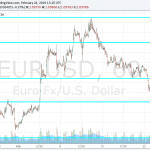
Many markets are closed in Asia, and although Tokyo managed posted equity gain, most other markets in the region that were open fell. And the selling pace picked up in Europe. The Dow Jones Stoxx 600 is off 2.3%, led by information technology, industrials, and consumer discretionary. It is trading at new lows since late-2014. It is the sixth consecutive losing session, which is the longest such streak in seven months.
Rather than a new trigger, the equity losses today seem to be a continuation of what investors have been experiencing. The same is broadly true of the bond market. Core bond yields, including US Treasuries, bunds, and gilts are seeing a 2-5 bp decline while peripheral European bond yields are increasing. Aside from Greece, where negotiations over the first review, Portuguese bonds have come under strong pressure. The nearly 15 bp rise in the 10-year yield sees the premium over Germany widen beyond 300 bp for the first time since October 2014.
Oil reversed course. It initially rose on press reports of the Saudi Arabia-Venezuela meeting yesterday. We note that in the futures market, speculators have a record gross short light sweet crude position and the largest gross long position since last June. The front-month Brent contract is making new three-day lows. Support in the March light sweet crude contract may find support near $29.25.
The US dollar itself is mostly softer. Falling equities, which observers often mean by risk-off, is not weighing thedollar-bloc currencies, which often seems to be the case. Sterling is a bit heavier. After rising toward $1.4550 in late-Asia, sterling has shed three-quarters of a cent in the European morning to near the pre-weekend low. A break of it (~$1.4450) could spur another 1% decline toward $1.44.
The euro is trading within the pre-weekend range. Buying interest seemed to peter out as the euro approached $1.1180, but a stronger cap its seen in the $1.1200-$1.1220 area. Support is seen $1.1070-$1.1100.The news stream is light.














Leave A Comment